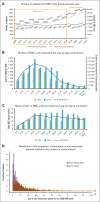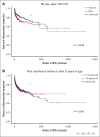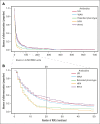Eleven years of alloimmunization in 6496 patients with sickle cell disease in France who received transfusion
- PMID: 37699002
- PMCID: PMC10790094
- DOI: 10.1182/bloodadvances.2022009328
Eleven years of alloimmunization in 6496 patients with sickle cell disease in France who received transfusion
Abstract
Red blood cell (RBC) transfusion is a major therapy for sickle cell disease (SCD). Patients are at risk of forming antibodies to RBC antigens, which can result in the impossibility to find compatible units and can cause hemolytic transfusion reactions. This retrospective study investigates the evolution of RBC consumption and the frequencies, specificities, and chronology of the appearance of antibodies in a population of patients consistently receiving RH (C, D, E, c, e) and K-matched RBC units (RBCus) from a predominantly European donor population. Over the 11-year period in the Paris area, 6496 patients received transfusion at least once for a total of 239 944 units. Antibodies were made by 1742 patients. The first antibodies of a patient were predictive of subsequent immunization. By the 17th RBCu transfused (by the 20th, excluding warm autoantibodies), 75% of the patients who would make antibodies had made their first. By the 16th, 90% who would make antibodies to a high frequency antigen had made their first antibody to these antigens. Females made their first antibodies slightly earlier than males. Patients who received multiple transfusions (>50 units) had a higher immunization prevalence than those who rarely received transfusion (<12 units) but fewer clinically significant antibodies. Patients with SCD and prophylactic RH-K matching not immunized by the 20th RBCu are likely to have a low alloimmunization risk (to antigens other than RH-K), that is, be low responders, especially relative to the most clinically significant antibodies. This number of 20 units is a point before which close monitoring of patients is most important but remains open to future adjustment.
© 2023 by The American Society of Hematology. Licensed under Creative Commons Attribution-NonCommercial-NoDerivatives 4.0 International (CC BY-NC-ND 4.0), permitting only noncommercial, nonderivative use with attribution. All other rights reserved.
Conflict of interest statement
Conflict-of-interest disclosure: The authors declare no competing financial interests.
Figures







Similar articles
-
Effects of prophylactic red blood cell (RBC) transfusion with extended antigen matching on alloimmunization in patients with Sickle Cell Disease (SCD).Transfus Apher Sci. 2023 Dec;62(6):103813. doi: 10.1016/j.transci.2023.103813. Epub 2023 Sep 14. Transfus Apher Sci. 2023. PMID: 37743224
-
Clinical significance of RBC alloantibodies and autoantibodies in sickle cell patients who received transfusions.Transfusion. 2002 Jan;42(1):37-43. doi: 10.1046/j.1537-2995.2002.00007.x. Transfusion. 2002. PMID: 11896310 Review.
-
Red blood cell alloimmunization and minor red blood cell antigen phenotypes in transfused Ghanaian patients with sickle cell disease.Transfusion. 2019 Jun;59(6):2016-2022. doi: 10.1111/trf.15197. Epub 2019 Feb 13. Transfusion. 2019. PMID: 30758856
-
Immune erythrocyte antibodies in adult patients with sickle cell disease and blood donors in Lagos, Nigeria: a comparative study.Immunohematology. 2021 Sep;37(3):131-137. doi: 10.21307/immunohematology-2021-020. Immunohematology. 2021. PMID: 34591378
-
Impact of Red Blood Cell Antigen Matching on Alloimmunization and Transfusion Complications in Patients with Sickle Cell Disease: A Systematic Review.Transfus Med Rev. 2019 Jan;33(1):12-23. doi: 10.1016/j.tmrv.2018.07.003. Epub 2018 Jul 26. Transfus Med Rev. 2019. PMID: 30122266
Cited by
-
Building awareness: Introducing education about blood-product donation in the school curriculum.Transfusion. 2025 Apr;65(4):750-757. doi: 10.1111/trf.18185. Epub 2025 Mar 2. Transfusion. 2025. PMID: 40025819 Free PMC article. No abstract available.
-
Dynamics of antibody engagement of red blood cells in vivo and in vitro.Front Immunol. 2024 Nov 28;15:1475470. doi: 10.3389/fimmu.2024.1475470. eCollection 2024. Front Immunol. 2024. PMID: 39669570 Free PMC article.
-
IFN-I promotes T-cell-independent immunity and RBC autoantibodies via modulation of B-1 cell subsets in murine SCD.Blood. 2025 Jan 16;145(3):334-347. doi: 10.1182/blood.2024025175. Blood. 2025. PMID: 39656114
References
-
- Vichinsky EP, Earles A, Johnson RA, Hoag MS, Williams A, Lubin B. Alloimmunization in sickle cell anemia and transfusion of racially unmatched blood. N Engl J Med. 1990;322(23):1617–1621. - PubMed
-
- Natukunda B, Schonewille H, van de Watering L, Brand A. Prevalence and specificities of red blood cell alloantibodies in transfused Ugandans with different diseases. Vox Sang. 2010;98(2):167–171. - PubMed
MeSH terms
Substances
LinkOut - more resources
Full Text Sources
Medical

